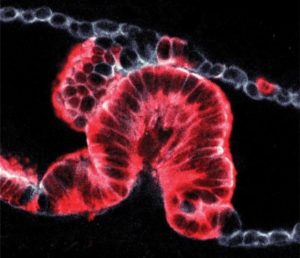
The new method could help researchers to get more information from tissue biopsies and may lead to improved treatments for pancreatic cancers. The technique was developed by scientists at the Francis Crick Institute, and their results are published in the journal Nature.
The pancreas sits behind the stomach and plays a key role in digestion. It relies on a network of ducts linking it to other digestive organs, and the most common pancreatic cancers are found in these ducts. However, until now it has only been possible to see 2D slices of these ductal cancers, which contained an unexplained variety of abnormal shapes.
The research team spent six years developing a new method to analyse cancer biopsies in three dimensions. Dr Hendrik Messal from the Francis Crick Institute, co-lead author of the research paper said: “This technique revealed that cancers develop in the duct walls and either grow inwards or outwards depending on the size of the duct. This explains the mysterious shape differences that we’ve been seeing in 2D slices for decades.”
By analysing developing cancers in 3D, the team defined two distinct types of cancer formation originating from ductal cells: ‘endophytic’ tumours which grow into the ducts and ‘exophytic’ tumours which grow outwards. To find out what makes cancer cells grow in a particular way, they analysed detailed 3D images and worked with biophysicists at the Crick who created sophisticated computer models.
“We made a simulation of the ducts, describing individual cell geometry to understand tissue shape,” explains biophysicist Dr Silvanus Alt, co-lead author of the paper. “The model and experimental results both confirmed that cancer grew outwards when the diameter of the duct was less than approximately twenty micrometres, around a fiftieth of a millimetre.”
The work was made possible by an interdisciplinary collaboration between two research groups at the Crick, led by Dr Axel Behrens and Dr Guillaume Salbreux. Axel’s group works on stem cells and pancreatic cancer, while Guillaume focuses on using physics to understand biological processes.
Says Axel: “We now have a patented technique to see the three-dimensional shapes of cancers and a biophysical understanding of the emergence of tumours. Now that we know pancreatic cancer can develop in these two different ways, we can start looking at whether one is likely to be more aggressive or spread in a different way. Many years from now, this could lead to improved diagnostic or treatment options.”
The team also applied the technique to other organs, and found that cancers in the airways of the lungs and ducts in the liver behave in the same way. This shows that the mechanism the teams discovered is not specific to the pancreas and also applies to other cancers.
The work was supported by the European Research Council and core funding from Cancer Research UK, the Medical Research Council and Wellcome.
